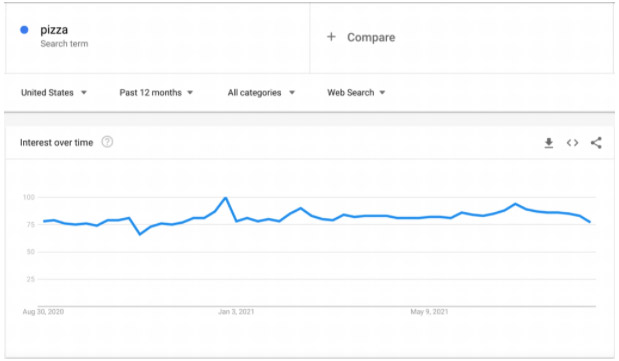How To Search A Keyword For Volume: Tips and Tricks
September 23, 2021 •DJ Team

If you’re developing an organic content marketing strategy, one of the most important things you can do is find and use the right keywords to capture the right traffic for your website. After all, organic search can bring huge influxes of traffic to sites—without having to spend any ad dollars at all.
In fact, over 50% of all website traffic comes in from organic searches, so it makes sense to develop a comprehensive strategy to capitalize on search.
But how do you find the right keywords? Well, for starters, you should use an SEO keyword research tool. Of course, it’s not as simple as that.
In this article, we’ll explore how to find the right keywords to target by analyzing keyword search volume, and how an accurate keyword search volume can help you develop a better strategy.
But first, let’s explore what search volume means for search engine optimization (SEO) purposes.
What is Search Volume?
In SEO, search volume is a metric that describes how many people are searching for a particular keyword or phrase over a given period of time.
For example, you might look at keyword volume for average monthly searches, especially for seasonal keywords like “Halloween costumes” or “Valentine's Day gifts” to better understand when to capitalize on keyword popularity.
Or, you might analyze search volume over the course of a year to understand how a keyword trends over a longer length of time.
What is a Good Search Volume for a Keyword?
At the most basic level, a good search volume for a keyword is high. And while “high” might vary depending on your industry (“shoes” for example, is probably going to be higher than “garage door openers” since it’s more applicable to more people), generally speaking, you’re looking for keywords with at least 100-1,000 searches per month.
But a good SEO strategy doesn’t operate at the most basic level and understanding what a good search volume is and isn’t is an art, not a science. It’s more complex than just finding keywords with a high search volume. It’s about finding high-volume keywords that aren’t completely saturated by competition.
But what does that mean exactly? Let’s take a look at an example.
Say you’re a new artisan pizza restaurant in Indianapolis. The word “pizza” has a high search volume, because who doesn’t love (and search for) pizza? But, the big nationwide chains like Pizza Hut and Domino’s have made competition high for the term. While not impossible, it’ll be hard for your brand to hit the first page of Google for “pizza.”
So instead, your pizza restaurant may have better luck with keywords like “pizza in Indy” or “artisan pizza.” These keywords still have a high search volume, but may have less competition than the generic keyword “pizza.”
In summation: focus too much on words with an exceedingly high search volume and you’ll face major competition from big-name brands. But, focus too much on low search volume keywords and you’ll run the risk of competing for terms that people just aren’t searching for.
So, while there’s no magic number for what a good search volume is, it’s all about finding a balance.
How Do I Find Search Volumes?
The good news is, most SEO keyword research tools display search volume. However, tools share keyword volume numbers in different ways.
Let’s explore how Google displays search volume information on some of its free tools.
How do I find Google Keyword Search Volume on Google Trends?
Google Trends, one of Google’s free SEO tools, is a tool to see what people are searching for at a given time. To find out about search volume, simply type your keyword into the box on the Google Trends homepage and you’ll be taken to a results page that looks something like this.

The higher the interest (on a 100 point scale) the higher the search volume. You can filter by location, timeframe, and more to get a better understanding of search volume.
Google Trends also displays keywords that are currently trending. And while this product is free, it doesn’t display the detailed search volume that marketers may be looking for.
How Do I Search Volume on Google Keyword Planner?
Google Keyword Planner is another free SEO tool from Google. To find the Google Keyword Planner search volume, simply enter a keyword in the “Get Search Volume and Forecast” function.
This function allows users to filter by location, date—including average monthly searches, competition, language, and more to really target the right keywords for your company.
However, one thing Google Keyword Planner lacks is detail about search volume. Their tool provides search volume in broad buckets (0-100, 100-1k, 1k-10k, 10k-100k, and 100k-1M) that may not be the most useful. Consider, for example, that a term with 10,001 searches falls into the 10k-100k bucket. Still, it’s a good tool to use to get started.

DemandJump: A Better Keyword Research Tool
Google’s free SEO tools are a great jumping-off point.
But for marketers looking for a product that will automate their research process and give them a competitive edge, Google’s tools are lacking. That’s where DemandJump comes in.
DemandJump was built by marketers, for marketers, to help companies make sense of marketing data and increase the efficacy of their organic and paid marketing efforts.
DemandJump provides comprehensive insight reports for companies to help them understand what keywords are being searched for, how frequently people are searching for them, and how steep the competition is.
Find high volume, high impact keywords with DemandJump. Then, generate one-click outlines to get started writing content immediately.
Ready to see just how easy it can be? Get started today!
Featured Articles
Categories
- Attribution Tracking (13)
- Channel Optimization (11)
- Consumer Insights (68)
- Content Marketing (251)
- Data Science (8)
- Digital Marketing (6)
- Digital Transformation (26)
- Enterprise (10)
- Lead Generation (14)
- Market Intelligence (8)
- Marketing Analytics (39)
- Marketing Attribution (57)
- Marketing Management (153)
- Marketing Operations (86)
- Organic Search (222)
- Paid Search (52)
- Pillar-Based Marketing (63)
- Programmatic Advertising (9)
- SaaS Content (14)
- SaaS Marketing (29)
- Search Marketing (111)
- SEO Keyword Research (28)
- SEO Pillar (18)
- SEO Strategy (46)
- SMB (5)
- Website Content (12)


